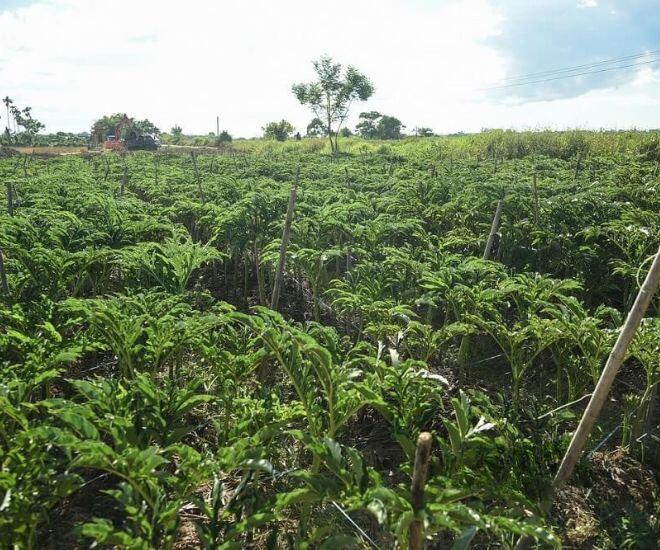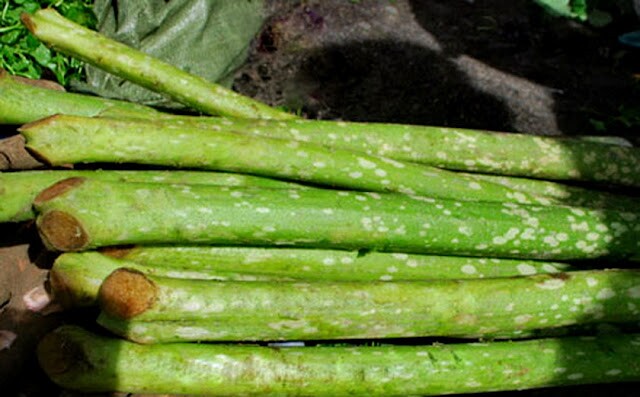
The lush green fields of nưa, with their distinctive lobed leaves resembling papaya, were once an integral part of the Hue countryside. The edible part of the nưa plant, known as chột nưa, has a unique sweet taste. While the nưa tuber causes itchiness when eaten, it is cherished by farmers who carefully dry and store it on their kitchen racks for the next planting season—a testament to their reverence for every inch of land and every seed during those challenging times.
To cultivate nưa, Hue locals select dry fields, creating raised beds with loose, crumbly soil. Each nưa tuber is carefully placed in rows within the furrows and covered with straw. Typically, each bed has two straight, parallel rows, forming a peaceful and orderly rural landscape. As the nưa sprouts, each tuber produces one to three tender shoots, known as chột nưa, which are plump and vibrant, ready to grace the table with a rustic flavor.

Not only are the tender shoots of the nưa plant valued, but the tubers also play a significant role. As the chột nưa turns yellow and withers, it’s time to harvest the nưa tubers, which are the size of an adult’s fist and come with “đáu” (small sprouts). After washing, the tubers are buried in white sand to absorb moisture and then boiled. Peeling away the outer layer, one can enjoy the “đáu” with its chewy texture and the slightly crumbly tuber, seasoned with a pinch of salty chili sauce, offering a unique sensory experience exclusive to Hue’s nưa.
Interestingly, not every region can cultivate nưa with edible and delectable tubers like Hue. Only four areas with “special” soil characteristics produce the renowned nưa: the villages of Hương Sơ and La Chữ in Hương Trà district and Phú Lễ and Niêm Phò in Quảng Điền district, the latter being the hometown of General Nguyễn Chí Thanh and poet Tố Hữu. The distinctive and exceptional flavor of nưa grown in these regions has transformed it into a rare and sought-after delicacy.

In bygone days, nưa was a staple crop in every household, not only for consumption but also for sale. Bundles of chột nưa, neatly tied with bamboo strips, filled baskets and were carried to the market by local women. The scene of these women cutting chột nưa in the evenings and heading to the morning market at dawn became an integral part of the local culture.
Moreover, chột nưa played a central role in family gatherings, especially during the cold winter months. Men and boys would gather to drain the water between the nưa beds, catching fish like snakehead, rohu, and catfish. These fish, cooked with chột nưa, created a mouthwatering dish. A steaming pot of chột nưa and snakehead fish soup, fragrant with the aroma of fish, the vibrant red of chili oil, and the golden hue of fish roe, was a feast for both the eyes and the palate, providing warmth on chilly days.
However, the ultimate Hue delicacy, synonymous with the flooded winters of Thua Thien-Hue, is chột nưa stewed with small floodplain fish. This dish is prepared with various fish, including cấn, mại, mương, and sơn, collectively known as “cù” (schooling fish) by locals. The Hue people invented this dish to combat the bone-chilling dampness of the winter season.

The preparation is simple: peel and slice the chột nưa into thick pieces, about the width of a finger. Clean the small fish, leaving the heads and intestines intact, and season with fish sauce, salt, pepper, scallions, and a bit of pork fat. The stew is then cooked with just enough water. The uniqueness of this rustic dish lies in the whole small fish, imparting a distinct bitter-sweet, nutty, and slightly astringent taste that lingers on the palate. Anyone who tries this dish is likely to crave it again, as evidenced by its appearance in Tố Hữu’s poetry, solidifying its place in Vietnamese culture.
Beyond the legendary stew, chột nưa is used in various soups and stews, from sour soup with small catfish (cá hẻn mồi) or snakehead fish (cá lóc) to chột nưa cooked with shrimp or pork. Chột nưa is also a common ingredient in hot pots, adding a sweet and crunchy texture.

Additionally, the people of Hue have created a unique and simple dish, unlike anywhere else: pickled nưa or chột nưa. The pickling process is similar to that of pickled cabbage or taro stem, but the resulting pickled nưa has a more aromatic and nutty flavor, and it never causes mouth itchiness. This pickle is commonly served with grilled fish, especially grilled snakehead fish dipped in ginger fish sauce. During the rainy season, it can also be enjoyed with a little “something strong” to warm the body.
Today, only a handful of people continue to cultivate nưa, primarily to cater to discerning diners seeking the flavors of yesteryear and wishing to relive culinary memories. Consequently, nưa has become an even more exotic and precious culinary heritage, a part of the enduring cultural legacy of the ancient capital that speaks of resilience, love, and enduring cultural values.
The Ultimate Beef Jerky Salad: A Local Favorite for 26 Years at Thanh Ha Market
Tucked away near Ô Quan Chưởng, this quaint little eatery offers a delightful culinary experience. With dishes such as the refreshing beef salad, priced at only 25,000 VND per bowl, and the delicious bánh bột lọc (cassava cake) at just 5,000 VND each, it’s no wonder that this hidden gem has become a favorite spot for Hanoi’s discerning snackers.
The Half-Century-Old Market in Dong Nai: A Culinary Gateway to Hue’s Delights in the Heart of the Mekong Delta
Over half a century since its establishment, Cho Quang Bien has become more than just a bustling trading hub; it is a sanctuary for Hue’s soul in the heart of the Mekong Delta. Here, the cultural and culinary traditions of Central Vietnam are preserved and creatively evolved, offering a unique glimpse into the region’s rich heritage.
Exploring the Largest Lai Chau Fair: A Journey Worthy of Hundreds of Kilometres
Lai Chau’s San Thang Market, located about 5 km from the city center, retains the unique charm of a highland market. It vividly reflects the cultural identity of various ethnic groups, including the Tay, Mong, Dao, Giay, and Lu. This market has become an appealing destination for tourists visiting Lai Chau.



































